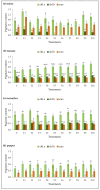Growth-Promoting Effects of Ten Soil Bacterial Strains on Maize, Tomato, Cucumber, and Pepper Under Greenhouse Conditions
- PMID: 40573862
- PMCID: PMC12196750
- DOI: 10.3390/plants14121874
Growth-Promoting Effects of Ten Soil Bacterial Strains on Maize, Tomato, Cucumber, and Pepper Under Greenhouse Conditions
Abstract
Beneficial interactions between plants and bacteria are crucial in agricultural practices, as bacteria can improve soil fertility, promote plant growth, and protect plants from pathogens. This study aimed to molecularly identify and characterize soil bacterial isolates and evaluate their effect on the growth of maize (Zea mays L.), tomato (Solanum lycopersici L.), cucumber (Cucumis sativus L.), and pepper (Capsicum annuum L.) under greenhouse conditions. Plant growth parameters, including plant height, root length, and fresh (FW) and dry (DW) weights, were measured. Additionally, pigment extraction and element content analysis using leaves were performed. Among the isolates, the most effective strain in the greenhouse experiment was Bacillus safensis SCF6, which significantly enhanced plant height and fresh weight across all tested plants, with the greatest influence observed in maize plant height (439.42 ± 6.42 mm), fresh weight (14.07 ± 0.87 g plant-1 FW), and dry weight (1.43 ± 0.17 g plant-1 DW) compared to the control (364.67 ± 10.33 mm, 9.20 ± 1.16 g plant-1 FW, and 0.92 ± 0.15 g plant-1 DW, respectively). Other strains also demonstrated notable results, with Microbacterium testaceum SCF4, Bacillus mojavensis SCF8, and Pseudomonas putida SCF9 showing the highest plant growth-promoting effects on pepper, tomato, and cucumber, respectively. Pseudomonas putida SCF9 demonstrated strong antifungal activity against Monilinia laxa, with a percentage of mycelial growth inhibition (PGI) of 72.62 ± 2.06%, while Bacillus subtilis SCF1 exhibited effects against Botrytis cinerea (PGI = 69.57 ± 4.35%) and Cercospora sp. (PGI = 63.11 ± 1.12%). The development and application of beneficial bacterial inoculants or their formulated products can contribute to environmentally friendly farming practices and global food security.
Keywords: characterization; elemental content; identification; pigment content; plant morphological parameters; seed inoculation.
Conflict of interest statement
The authors declare no conflicts of interest.
Figures




Similar articles
-
Phylogenetic analysis of plant-pathogenic and non-pathogenic Trichoderma isolates on maize from plants, soil, and commercial bio-products.Appl Environ Microbiol. 2025 Mar 19;91(3):e0193124. doi: 10.1128/aem.01931-24. Epub 2025 Feb 27. Appl Environ Microbiol. 2025. PMID: 40013788 Free PMC article.
-
Exogenous Melatonin Induces Salt Stress Tolerance in Cucumber by Promoting Plant Growth and Defense System.Life (Basel). 2025 Aug 14;15(8):1294. doi: 10.3390/life15081294. Life (Basel). 2025. PMID: 40868942 Free PMC article.
-
Mangrove-associated halotolerant bacteria augments salinity stress tolerance in Solanum lycopersicum.Plant Sci. 2025 Oct;359:112642. doi: 10.1016/j.plantsci.2025.112642. Epub 2025 Jul 2. Plant Sci. 2025. PMID: 40614935
-
Tomato brown rugose fruit virus: An emerging and rapidly spreading plant RNA virus that threatens tomato production worldwide.Mol Plant Pathol. 2022 Sep;23(9):1262-1277. doi: 10.1111/mpp.13229. Epub 2022 May 22. Mol Plant Pathol. 2022. PMID: 35598295 Free PMC article. Review.
-
Behavioral interventions to reduce risk for sexual transmission of HIV among men who have sex with men.Cochrane Database Syst Rev. 2008 Jul 16;(3):CD001230. doi: 10.1002/14651858.CD001230.pub2. Cochrane Database Syst Rev. 2008. PMID: 18646068
Cited by
-
Carrier-Based Application of Phyto-Benefic and Salt-Tolerant Bacillus wiedmannii and Bacillus paramobilis for Sustainable Wheat Production Under Salinity Stress.Plants (Basel). 2025 Jul 8;14(14):2096. doi: 10.3390/plants14142096. Plants (Basel). 2025. PMID: 40733333 Free PMC article.
References
-
- Murad H., Nyc M.A. Evaluating the potential benefits of cucumbers for improved health and skin care. J. Aging Res. Clin. Pract. 2016;5:139–141. doi: 10.14283/jarcp.2016.108. - DOI
-
- Batool M. Nutrient management of maize. In: Kaushik P., editor. New Prospects of Maize. IntechOpen; London, UK: 2024. - DOI
-
- Whitcomb S.J., Heyneke E., Aarabi F., Watanabe M., Hoefgen R. Mineral nutrient depletion affects plant development and crop yield. In: Hawkesford M.J., Kopriva S., De Kok L.J., editors. Nutrient Use Efficiency in Plants: Concepts and Approaches. Volume 10. Springer; Cham, Switzerland: 2014. pp. 205–228. - DOI
-
- Dhankhar N., Kumar J. Impact of increasing pesticides and fertilizers on human health: A review. Mater. Today Proc. 2023 doi: 10.1016/j.matpr.2023.03.766. in press . - DOI
LinkOut - more resources
Full Text Sources

